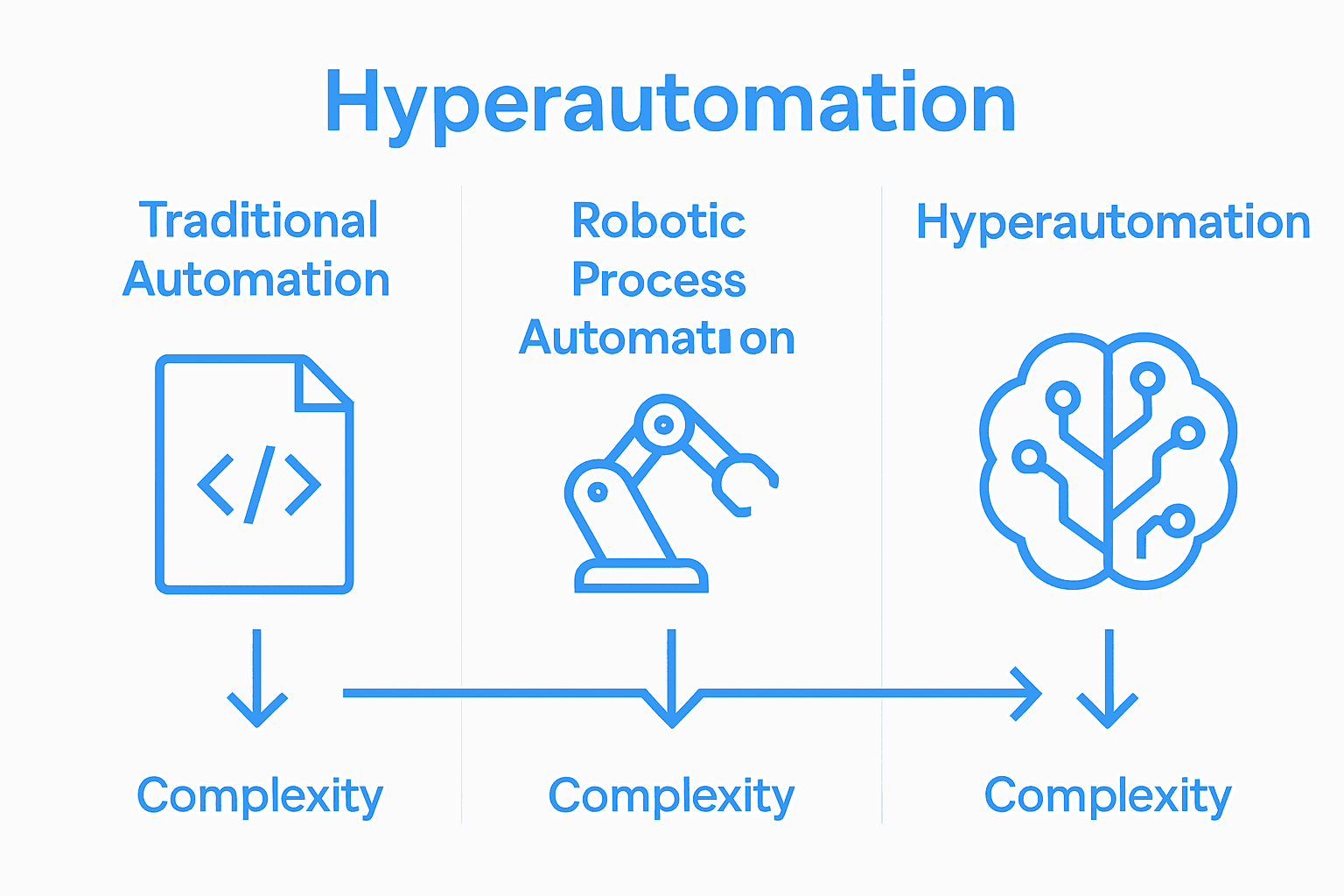Did you know that businesses can speed up operations by as much as 60 percent with automation? Complex tasks that once required hours now finish in minutes, reshaping how companies work every day. The shift toward Business Process Automation means fewer mistakes, lower costs, and teams focused on bigger goals. This guide breaks down how automation changes workflows, saves time, and helps organisations unlock new levels of productivity.
Key Takeaways
| Point | Details |
|---|---|
| Understanding BPA | Business Process Automation automates complex workflows, increasing productivity and reducing operational costs while minimizing human error. |
| BPA Approaches | Three primary automation strategies include Traditional Automation, Robotic Process Automation (RPA), and Hyperautomation, catering to varying levels of process complexity. |
| Implementation Challenges | Organizations face obstacles such as technical complexity and employee resistance; successful navigation requires thorough readiness assessments and stakeholder involvement. |
| Strategic Scaling | For effective BPA deployment, identify high-impact processes, assess readiness, and develop a phased implementation strategy aligned with business objectives. |
Table of Contents
- What Is Business Process Automation
- Comparing Bpa Approaches: Rpa To Hyperautomation
- How Business Process Automation Works
- Benefits And Real‑World Use Cases
- Key Challenges And Risk Mitigation
- Selecting And Scaling Bpa Solutions
What Is Business Process Automation
Business Process Automation (BPA) transforms how organisations manage complex workflows by strategically deploying software technologies to streamline repetitive tasks with minimal human intervention. According to research from IBM, BPA focuses on automating intricate business processes like order processing, customer account management, and employee onboarding.
At its core, BPA leverages advanced technologies such as process intelligence, intelligent automation tools, and cloud platforms to complete business operations more efficiently. As insights from TechTarget highlight, the primary objectives of BPA include:
- Increasing overall organisational productivity
- Reducing operational costs
- Minimising human error
- Improving customer service quality
- Enhancing compliance and auditing capabilities
By strategically implementing BPA, businesses can redirect human talent from mundane, repetitive tasks towards more strategic, creative initiatives that drive innovation and growth. Think of it like having a digital workforce that handles routine processes with precision, allowing your team to focus on solving complex challenges and creating value.
Comparing BPA Approaches: RPA to Hyperautomation
Businesses today have multiple approaches to Business Process Automation (BPA), each offering different levels of technological sophistication and operational impact. According to research from Wikipedia, three primary automation strategies exist: traditional programming-based automation, Robotic Process Automation (RPA), and Hyperautomation.
Robotic Process Automation (RPA) represents an initial stage of automation where software bots systematically mimic human interactions with digital systems. As explained by Blue Prism, RPA excels at automating specific, rule-based tasks with predefined workflows. These bots can handle repetitive actions like data entry, form processing, and basic transaction management with remarkable precision.
Hyperautomation takes automation to a more advanced level by integrating multiple intelligent technologies. This approach combines:
- Robotic Process Automation (RPA)
- Artificial Intelligence (AI)
- Machine Learning (ML)
- Optical Character Recognition (OCR)
- Advanced document processing tools
The goal of Hyperautomation is to create a comprehensive, intelligent automation ecosystem that can dynamically discover, validate, and automate complex business processes with minimal human intervention. By leveraging these interconnected technologies, organisations can achieve unprecedented levels of operational efficiency, adaptability, and strategic insight.
Here’s a comparison of the main Business Process Automation approaches:
| Approach | Key Technologies | Suitable For |
|---|---|---|
| Traditional Automation | Scripting Programming |
Simple, rule-based tasks |
| Robotic Process Automation (RPA) | Software bots Workflow automation |
Repetitive, structured processes |
| Hyperautomation | RPA AI & ML OCR |
Complex, cross-functional workflows |
How Business Process Automation Works
Business Process Automation (BPA) operates through a sophisticated network of integrated technologies that transform complex business workflows into seamless, intelligent processes. According to IBM’s research, BPA leverages enterprise IT systems, workflow orchestration tools, Robotic Process Automation (RPA), Business Process Management (BPM) software, artificial intelligence, and cloud platforms to automate multi-step operations.
At the heart of BPA are automated workflows with intelligent trigger mechanisms. As explained by Dataconomy, these workflows initiate sequences of tasks that execute automatically, dramatically reducing manual effort and minimising potential human errors. For instance, a typical workflow might include:
- Detecting a specific event or condition
- Automatically initiating a predefined sequence of actions
- Executing tasks across different systems and departments
- Generating reports and notifications
- Ensuring compliance and tracking progress
By understanding automation in ecommerce, businesses can see how these workflows might manifest practically. Imagine an inventory system that automatically triggers purchase orders when stock levels drop, simultaneously updating suppliers, generating trend reports, and forecasting future demand—all without manual intervention. This is the transformative power of Business Process Automation: turning complex, time-consuming tasks into efficient, error-free digital processes.

Benefits And Real‑World Use Cases
Business Process Automation (BPA) delivers transformative benefits across various organisational domains. According to IBM’s research, BPA systematically enhances operational efficiency by automating routine activities like employee onboarding, invoice processing, contract management, and complex marketing and sales workflows.
A comprehensive APQC survey revealed that 84% of organizations experienced significant improvements through automation. The key benefits organisations consistently report include:
- Streamlined Processes: Reducing bottlenecks and inefficiencies
- Cost Savings: Minimising manual labour and operational expenses
- Enhanced Quality: Reducing human error and standardising procedures
- Improved Data Management: Creating more accurate and accessible information systems
- Strategic Decision-Making: Providing real-time insights and analytics
Practical use cases span multiple industries. Learn more about automation in digital marketing, where automated workflows can manage email campaigns, social media scheduling, lead nurturing, and customer segmentation. In finance, BPA helps automate invoice processing, payroll management, and compliance reporting. Healthcare organisations use automation for patient record management, appointment scheduling, and insurance claim processing. Manufacturing sectors leverage BPA for inventory tracking, supply chain management, and predictive maintenance scheduling. Each of these examples demonstrates how intelligent automation can transform complex, time-consuming tasks into efficient, error-free digital processes.

Key Challenges And Risk Mitigation
Business Process Automation (BPA) implementation is not without significant challenges. According to IBM’s research, organisations frequently encounter complex obstacles that require strategic navigation, including difficulties in scaling automation across diverse tasks and synchronising human-machine interactions.
The primary challenges organisations face include:
- Technical Complexity: Integrating automation across multiple systems
- Change Management: Addressing employee resistance and skill gaps
- Process Documentation: Ensuring clear, comprehensive workflow mapping
- Technology Selection: Choosing appropriate automation tools
- Performance Measurement: Defining and tracking meaningful metrics
Successful risk mitigation demands a systematic approach. As IBM recommends, organisations should:
- Assess organisational readiness thoroughly
- Launch well-scoped pilot projects
- Involve key stakeholders from multiple departments
- Define clear, measurable automation goals
- Provide comprehensive staff training and support
- Continuously measure outcomes and iterate
Learn more about automation in digital marketing to understand how strategic implementation can help overcome these challenges. By adopting a measured, collaborative approach, businesses can transform potential risks into opportunities for operational excellence and innovation.
Selecting And Scaling BPA Solutions
Business Process Automation (BPA) requires a strategic, systematic approach to selection and implementation. According to IBM’s research, organisations must carefully assess their automation readiness, identifying high-impact processes and establishing a comprehensive long-term automation framework aligned with strategic business objectives.
A recent APQC study highlighted the most promising functional areas for initial BPA deployment:
- Process Management: Standardising and optimising core workflows
- Finance: Automating accounting, reporting, and compliance tasks
- Customer Service: Streamlining support and engagement processes
- Supply Chain: Managing inventory, logistics, and procurement
- Sales: Enhancing lead generation, tracking, and conversion workflows
Successful BPA implementation involves a structured approach:
- Conduct a comprehensive organisational readiness assessment
- Identify processes with clear business value and measurable impact
- Involve key stakeholders from multiple departments
- Choose between ready-made or low-code automation solutions
- Develop a phased implementation strategy
Learn more about automation in ecommerce to understand how targeted automation can transform specific business functions. By adopting a methodical, strategic approach, organisations can effectively scale their BPA initiatives, driving operational efficiency and competitive advantage.
Make Business Process Automation Work for You
You have seen how complex and overwhelming managing business processes can become without the right technology. The struggle to scale operations, reduce manual errors, and keep your team focused on what matters is real. Whether you face challenges with integrating automation tools or want to future-proof your business with solutions like Robotic Process Automation or Hyperautomation, the right digital partner can help your company thrive.
Ready to streamline your workflows and experience the power of automation? Discover how tailored development, cloud services, and strategic digital transformation from Cloudfusion can unlock new levels of efficiency. Secure your personalised web design and development quotation today. Let us show you how our expertise in business process improvement, digital marketing, and scalable web solutions empowers South African organisations to move ahead—do not wait to transform your operations for tomorrow’s demands.
Frequently Asked Questions
What is Business Process Automation (BPA)?
Business Process Automation (BPA) involves transforming complex workflows within organizations by utilizing software technologies to automate repetitive tasks, aiming to increase productivity and reduce operational costs.
How does Robotic Process Automation (RPA) differ from Hyperautomation?
Robotic Process Automation (RPA) focuses on automating specific, rule-based tasks using software bots, while Hyperautomation integrates RPA with advanced technologies like AI and machine learning to automate complex, cross-functional workflows.
What are the main benefits of implementing Business Process Automation?
The primary benefits of BPA include streamlined processes, cost savings, enhanced quality, improved data management, and better strategic decision-making, resulting from automating routine activities across various organizational domains.
What challenges might organizations face when implementing BPA?
Organizations may encounter challenges such as technical complexity, change management issues, unclear process documentation, technology selection difficulties, and the need for effective performance measurement when implementing BPA.
Recommended
- Understanding Automation in Ecommerce: Key Concepts Explained
- How Automation in Digital Marketing Transforms Businesses
- Understanding Enterprise App Integration for Businesses
- Internet Marketing by Cloudfusion
- Healthcare Workflow Automation Trends and Solutions 2025
- Understanding the Instagram Content Automation Process








